"From each according to his ability and to each according to his need"
Karl Marx? Check. But it is also the message of a pontifical ignoramus: Pope Frank. The asshole obviously knows no history. Does he not know the vast evils that have been done under the mantle of that slogan? A Marxist nut for a Pope: Just what the world needs
Pope Francis wraps up the first leg of a three-nation South American pilgrimage today after issuing an impassioned call for a new economic and ecological world order where the goods of the Earth are shared by everyone, not just exploited by the rich.
Francis will visit the elderly and give a pep talk to local priests before flying to Bolivia, where the environment, ministering to the poor and the government's tense relations with the Catholic Church are high on the agenda.
Taking up the global warming issue in Quito on Tuesday, Francis pressed the arguments made in his headline-grabbing encyclical earlier this month that the planet must not be exploited by the wealthy few for short-term profit at the expense of the poor.
'The goods of the Earth are meant for everyone, and however much someone may parade his property, it has a social mortgage,' Francis said.
'The tapping of natural resources, which are so abundant in Ecuador, must not be concerned with short-term benefits.'
Ecuadorean President Rafael Correa has been harshly criticised by environmentalists and indigenous groups for pushing mining and oil drilling in the Amazon, which together with the Galapagos Islands make Ecuador one of the Earth's environmental priorities.
That push, coupled with high crude prices, allowed Correa to lift 1.3 million people out of poverty in his eight years in office.
South Polar Ice Age: Stations Show “Dramatic” Antarctic Peninsula Cooling Since 1998, Sea Ice Surge
By Ed Caryl
This is a follow-up to the article AWI’s Sloppy Antarctic Peninsula Science…Overlooked GISS Temperature Data, Snowfall Amounts. The reality is that the situation at the South Pole is worrisome.
Ocean around Antarctica markedly colder since 2006…
It is difficult to believe that global warming/climate change is doing anything to the glaciers of the Antarctic Peninsula and the Western Antarctic. Here is why: The ocean around Antarctica has been getting markedly colder since 2006; sea ice is increasing, especially since 2012; and land temperatures have been cooling since the El Niño of 1998.
0 – 100m ocean temperature plummeting:
Figure 1 is the upper 100 meters of ocean south of 60°S. There’s been a rapid cooling since about 2007. Negative numbers are used to select latitudes in the Southern Hemisphere. The source is KNMI, link.
Sea ice skyrockets…
Figure 2 is the Southern Hemisphere sea ice area anomaly. The source is KNMI, link.
Figure 3 is a plot of the annualized ocean temperature and Southern Hemisphere ice extent using the KNMI data from figures 1 and 2. Ocean temperature is inverted to show that the ice extent matches the cooling ocean. Note the correlation between the two curves.
Antarctic Peninsula sees dramatic cooling…
Figure 4 is a plot of the temperature anomalies at 13 Antarctic stations on or near the Antarctic Peninsula. The baseline is the 1998 to 2014 average for each. Antarctic peninsula has been cooling since 2000. Data source: GISTemp, link.
There is a lot a variation in the annual average temperatures for these stations, especially in the years where there were only two stations reporting, Esperanz and Faraday. For that reason, the average in figure 5 begins in 1963 when O’Higgins began reporting.
Figure 5 is the average anomaly for the stations in figure 4.
There were two peaks in temperature, one in 1989 and a second during the El Niño year of 1998 which caused a steep upward in temperature world-wide, and especially in Antarctica. But since then there has been a dramatic cooling. There is no “hiatus” on the Antarctic Peninsula, there is marked cooling.
Larsen Ice Shelf station cooling at a rate of 18°C per century
Cooling is especially true of the very location everyone is concerned about, the Larsen Ice Shelf. There is an automated weather station (AWS) there that has been reporting continuously since 1995.
Figure 6 is the annual average temperature at the Larsen Ice Shelf. The source is GISTemp.
Figure 6 shows the step in temperature in 1998 at the Larsen Ice Shelf. The trend in cooling after 1998 is 1.8°C/decade, the second fastest cooling on the Peninsula. Butler Island is cooling faster, at 1.9°C/decade.
Result: exploding sea ice
It is easy to see why the sea ice around Antarctica is increasing. The average ocean temperature from the surface to 100 meters dropped below the freezing point in 2008 and has stayed there. It is hard to melt ice when the water it is floating on is below the freezing point of fresh water, and seldom rises above that temperature.
The Southern Ocean around Antarctica has similar warming and cooling cycles as the North Atlantic, just not as strong. The cycle is now going negative, and temperatures on land and in the ocean are going sharply cooler, with ice increasing. There is no warm ocean water melting ice shelves from below. The ocean is getting colder and is below freezing most of the time. Any increase in ice calving off the glaciers must be from increased snow feeding those glaciers or geothermal heating from volcanism under the ice.
Welcome to reality.
The best renewable energy investment
By Marita Noon
solar panel installationWhen you read a headline such as one from CNBC touting “Solar power’s stunning growth,” realize that it’s thanks to you — even if you’ve never even thought of putting solar panels on your roof or live in an apartment where you couldn’t install them if you wanted to. If you live in the United States, vote, pay taxes, and get your electricity from a utility company, you’ve helped the solar power industry. You support the solar industry through a variety of tax and regulatory policies — voted in by politicians you elected — that favor it over other lower-cost forms of electricity generation.
The CNBC story from December 2014 that claims “US generation up 100 percent this year,” acknowledges the reality of my postulation. “Four major factors have made the solar surge possible,” it states. It, then, goes on to list them (Only one is the result of market conditions, with the other three relating to government policy.):
The extension of the Investment Tax Credit for renewable energy;
State renewable portfolio standards;
The Obama administration’s pro-solar policies, including friendly environmental reviews, cash grants in lieu of tax credits and guaranteed loans; and
The steep decline in the price of PV.
With such favorable conditions, solar may seem like a fail-safe investment — which is exactly what Sunrun is hoping for with its new initial public offering (IPO), expected to raise about $100 million. After all, the Wall Street Journal’s (WSJ) reporting on the Sunrun IPO points to SolarCity’s success: “shares have soared more than sixfold since its 2012 IPO.”
However, before investing, it would be wise to consider the changeable nature of politics. Tim Snyder, President of Agri-Energy Solutions, Inc. told me, “I spent years developing ethanol and biodiesel opportunities. That was in a time when everyone wanted to invest in them. When times were good you could expect payback of your initial investment in less than two years with skyrocketing internal rates of return. All it took to kill investor interest for these projects was for the government to turn its back on the standard corn-based ethanol plant.”
Snyder added, “The countryside is littered with the carcasses of investors who thought they were investing in the new energy wave for the future, in ethanol and biodiesel, only to have their hopes and cash robbed by a very conflicted energy policy. It’s just not a safe place to put your money without a real and comprehensive plan, and the federal government has no such plan. Remember the old saying, ‘The government giveth, and the government taketh away.’”
Sunrun, as WSJ summarizes, “installs solar panels on residential homes either for no upfront cost or at low cost. Sunrun owns the solar panels and receives monthly payments from homeowners for the power generated by the panels. It also receives government tax incentives to cover its costs.”
Reading through the 234 pages of fine print in Sunrun’s form S-1, filed on June 25 with the Securities and Exchange Commission, it becomes very clear that its past and future success is because of government policies. Government-dependent growth is why, on page 104, under the heading “Government Regulation,” Sunrun is committed to maintaining a “policy team to focus on the key regulatory and legislative issues impacting our entire industry.” The term “policy team” is gentlespeak, meaning lobbyists whose sole job is to insure policy favorable to its business model, as the S-1 explains, “We plan to continue to invest in building out our team to shape the dialogue and promote a policy framework that will be beneficial.”
Just how “beneficial” is the “policy framework”? The answer is found a few paragraphs down: “These incentives enable us to lower the price we charge homeowners for energy from [solar], and to lease energy systems, helping to catalyze homeowner acceptance of solar energy as an alternative to utility-provided power.”
Under the heading “Policies and Incentives” the S-1, on page 89, outlines the three specific “federal, state, and local policies” that have “been strong factors affecting the market for distributed solar generation.” They are the Federal Investment Tax Credit (ITC), net metering, and Solar Renewable Energy Credits and “other state incentives.”
The S-1 states, “Tax incentives have accelerated growth in U.S. solar energy system installations.” Under today’s policy, businesses and homeowners who install a solar system can receive a tax credit worth up to 30 percent of the system’s cost — though it is scheduled to drop to 10 percent on January 1, 2017. In bold print, page 18 states, “Our business currently depends on the availability of utility rebates, tax credits and other financial incentives in addition to other tax benefits. The expiration, elimination, or reduction of these rebates and incentives could adversely impact our business.” Extending the ITC is likely a top priority of the “policy team.” All U.S. taxpayers, then, are paying for solar’s “stunning growth.”
Net metering is essentially a “utility rebate,” that, according to page 18, provides “homeowners with a one-for-one full retail credit within a monthly billing period for electricity that the solar energy system exports to the electric grid.” Interestingly, the only states where Sunrun operates are those states that have “adopted net metering policies.” Sunrun’s S-1 acknowledges “we rely on net metering and related policies to offer competitive pricing to homeowners” and “changes in net metering policies may significantly reduce demand for electricity from our solar service offerings.” It continues addressing proposed changes and/or caps to net-metering policies, saying that if changes are made, homeowners “will be unable to recognize cost savings.” And, states that do not have favorable net-metering policies “would pose a barrier to entry.”
It is net-metering policies that have made all ratepayers shoulder the tab for solar’s “stunning growth.” As the S-1 points out, homeowners get “a one-for-one full retail credit” for the electricity the system generates. What it doesn’t make clear is that the policy requires the utility to pay the retail rate for electricity whether it needs it or not, and even though it can get lower-priced electricity from conventional sources. As a result, the utility is wasting money and not operating efficiently as a business must do to be profitable. This loss is a result of government policy, not bad management. Therefore, to stay in business, the utility has to raise rates on all its customers so that the few can benefit. Page 88 points out, “Residential solar has penetrated less than 1 percent of the 83 million single family detached homes in the United States.”
Many states are revisiting the generous net-metering policies that were put in place a decade ago when solar adoption was miniscule. In Arizona, where solar penetration is now the second highest in the country, homeowners who install new solar systems pay a fee for “plugging into the electric grid of Arizona Public Service.” Solar customers need to plug into the grid. Page 99 explains, “The home’s energy usage is provided by the solar energy system with any additional needs provided by the local utility.”
Tucson Electric Power wants to change to paying wholesale for the excess electricity homeowners sell to the grid — which, according to the Arizona Republic, “may mean solar power would no longer be a good buy for homeowners.”
Louisiana is reining in its generous solar tax credits with a bill signed into law on June 19. The Advocate reports, “During the recently adjourned legislative session, they capped solar spending at roughly $20 million next year and put in place tighter fraud controls.”
Citing a March report from GTM research, WSJ warns, “a number of new state laws ‘could impact residential solar’s value proposition’ due to changes in subsidies and electric rates.”
With all the claims of renewable energy reaching cost parity with conventional energy, realize this headline is only semi-accurate because government regulation is driving up the cost of conventional electricity while ratepayers and taxpayers are underwriting the cost of renewables.
For once, it is nice to see the solar industry acknowledge (on page 18) that, “Any of these changes could materially reduce the demand for our products and could limit the number of markets in which our products are competitive with electricity provided by the utilities.” As Sunrun states: “We focus our resources on markets with high electricity rates, favorable policy environments, and other characteristics that allow for low operational costs and favorable unit margins.”
If you are tired of having your tax dollars raise your electricity costs, benefitting the 1 percent while the 99 percent pays twice, the best investment you can make is to vote accordingly.
Let Them Have Solar Panels: New Obama Plan Doesn’t Help Poor, But Reducing Regulations Would
The White House is planning to give more than a half a billion dollars in government and private funding for solar panel installations for low and moderate-income households.
Too bad the White House is simultaneously hurting those same struggling Americans by pushing energy regulations that will hike their utilities costs.
The Obama administration plans to modify existing federal programs through executive order to triple the amount of solar systems on federally-subsidized housing. The administration also wants to make it easier for low-income families to take out loans up to $25,000 to install rooftop solar panels.
Is this really helping low-income families?
Actually, this could backfire and hurt low-income families by encouraging them to be exposed to more financial risk. The White House is directing the Federal Housing Administration to make it easier to borrow money and provide “flexible underwriting to recognize the reduced cost of utilities for energy efficient homes.”
In theory, the loans make sense because people could repay the loans with the money they’ve saved with lower utility bills. But if the solar electric systems installed fail to deliver the anticipated savings, home owners would still be on the hook to payback the full amount of the loan.
Furthermore, taking out a loan for a 20-year solar lease could present problems for low-income homeowners who opt to sell their homes. The seller would have to convince potential buyers to take over the loan, pay off the loan themselves or pay the solar company to take down the solar system and install it on their new homes.
Solar technology’s rapid development also creates potential problems. As the White House notes, the average cost of a solar electric system dropped 50 percent in the past 5 years. Do people want an old technology on their roof? How difficult will it be to renegotiate the contract? How easy will it be to transfer the system to a potential home buyer if that technology is already outdated?
If there is truly an opportunity to save money through solar installation, then private investors and developers should bear the risk of providing the loans. If solar (or any energy technology) is such a good idea, we shouldn’t need to convince anyone to install.
But when the government provides generous carve outs, that risk is distorted and places taxpayers on the hook for any failures.
What about the energy savings? Rep. Elijah Cummings, D-Md., who was born, raised and currently lives in Baltimore, remarked, “The difference in a monthly bill of $10 or $15 means a lot to the people who live on my block.”
Cummings’ statement is undoubtedly true. Higher energy bills essentially act as a regressive tax. While the median family spends about 5 cents out of every dollar on energy costs, low-income families spend about 20 cents.
We do need to make energy more affordable. But encouraging families through loans and subsidies to install solar panels is the wrong solution for that problem.
Energy costs for families would go down if regulations decreased. But instead of decreasing them, the Obama administration is implementing a series of energy regulations that will drive up costs and drive people out of work.
One of the biggest threats facing low-income Americans is the administration’s climate change regulations for new and existing power plants that will likely be finalized by the end of the summer.
According to a new study from the National Black Chamber of Commerce, the regulations “would have serious economic, employment, and energy market impacts at the national level and for all states, and that the impacts on low-income groups, blacks and Hispanics would be especially severe.” The study finds that from 2015-2035, black median household income would drop by more than $5,000 and Hispanic median household income would drop by more than $7,000. By 2020, black job losses total nearly 200,000 and Hispanic job losses total more than 300,000.
And the environmental benefit of the economic sacrifices low-income families that are struggling to make ends meet? A change in the earth’s temperature of a few hundredths of a degree Celsius.
Energy policies rooted in the principles of economic freedom lead to increased production, competition and access. Let’s not be duped by federal government gestures and special interests pursuing political and environmental agendas that deprive Americans access to affordable energy and greater prosperity.
As Bill Gates said, the cost of decarbonizing of our energy economy is “beyond astronomical.” And it’s the America’s poor who pay the highest cost.
Fracking is green
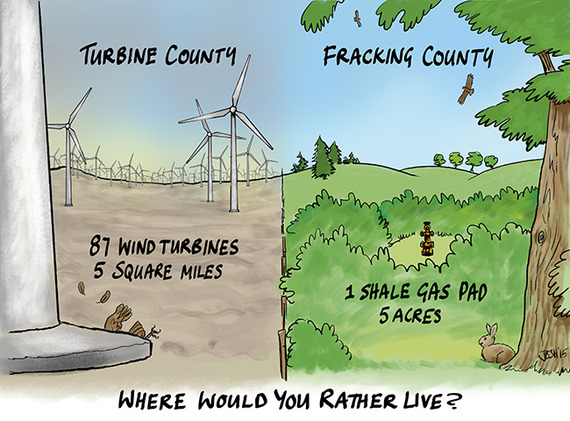
Last Sunday Christopher Booker wrote a brilliant article "Why are greens so keen to destroy the world's wildlife?" He says:
When Professor David MacKay stepped down as chief scientific adviser to the Department of Energy and Climate Change (Decc) last year, he produced a report comparing the environmental impact of a fracking site to that of wind farms.
Over 25 years, he calculated, a single "shalegas pad" covering five acres, with a drilling rig 85ft high (only needed for less than a year), would produce as much energy as 87 giant windturbines, covering 5.6 square miles and visible up to 20 miles away.
Which made me think: where would you rather live, in a county full of giant turbines littering the countryside, killing eagles and bats and producing unreliable electricity, or one with a small discreet gas tap somewhere?
GREENIE ROUNDUP FROM AUSTRALIA
Four current articles below
Climate scientists: More scared of an inquiry into the science than they are of climate change
What’s more terrifying to a climate scientist than “2 degrees” of warming? Answer: Half a degree of hard questions.
Australian climate scientists don’t complain at all when the UN says it wants to redirect $89 Trillion in a quest to change the climate. But they are suddenly all concerned that the Australian Government might waste 0.0001% investigating the science. A disaster! Since when were climate scientists concerned about wasting public money? Since never.
A group of thirteen scientists, who’ve personally achieved little in the way of scientific advances, have written to Dennis Jensen and Chris Back offering to brief them on the “latest science”, afraid the skeptics might launch an inquiry into the science. The ABC calls them “prominent”
Isn’t the scientific evidence the most important thing?
Surveys show half of the Australian public are skeptical — unconvinced by their claims that coal will cause a climate crisis or that solar panels can stop the storms. Right now, if the climate is headed for a disaster, nothing is more important than convincing the public. Instead, the climate scientists keep repeating that the debate is over, “trust us”, and “don’t ask questions”. But the debate never happened, the public don’t trust them, and we have many many questions — and they are not going away.
In a Reuters poll, 57% of people said they don’t think UN Climate Scientists can speak with authority on climate. Some scientists keep repeating that there is a consensus, but that spin isn’t working. More of the same isn’t going to change that. It’s time for a real debate.
If the evidence was overwhelming, 95% certain, the climate scientists would welcome the attention. But it’s a gambit they played ten years ago, and the game is over. Skeptics know the case for a crisis will fall over with the merest honest inspection. The unskeptical scientists know it too — that’s why they are so afraid the Coalition might really call their bluff and demand real answers.
The laws of physics are the same in every field
If there is a climate crisis, real scientists would have no trouble convincing other scientists from other fields, but that’s not what we are seeing. Increasingly scientists from other branches of science are protesting, and in their thousands. They are fed up at the way the scientific method is being abused and milked for press attention.
There is no consensus amongst scientists – only among certified “climate” scientists, paid by government. Almost half of meteorologists are skeptics (crikey!), survey after survey shows that two-thirds of geoscientists and engineers are skeptics, and most readers of skeptical blogs (who chose to respond to surveys and list their qualifications in comments) have hard science degrees.
Dan Kahan conducted a survey and found people who knew more about maths and science were more likely to be skeptical. In other words, skeptics were better informed about science. See the qualifications of 400 skeptics here.
How weak is their scientific position?
Dennis Jensen pointed out 97% of models did not predict “the Pause”. So Professor Hoegh-Guldberg simply denied there is a pause. (Hello? What about those satellites? Ignoring most of the big climate temperature data sets?) Probably the only paper in Professor Hoegh-Guldberg’s arsenal is the recent Karl et al one, which ignored the best ocean gauges and used a wildly uncertain estimate to blend two bad data sets together. What’s the certainty? The data was corrected with a figure where the error was 17 times larger than the correction: 0.12 ± 1.7°C. See, exotic adventures in global climate data to unfind “the Pause”. They must be kidding.
Hoegh-Guldberg says 18 years of a global temperature pause is “short term”:
But Professor Hoegh-Guldberg said that was a short-term perspective. “When you look at the literature, there’s been no hiatus,” he said.
“There’s random variability around the upward signal of temperature. “It’s just like the stock market. If you look at that it’s going up and down but it’ll have a trend — that trend is what we’re watching. “[It's] not whether it’s going up or down over a period of 10 years — it’s a long-term signal.”
18 years. 10 years, what’s the difference? It’s only math. ;- )
And oh, yes, please, Hoegh-Guldberg, let’s look at the long term. How many of the IPCC favourite climate models “predicted” the medieval warm period? How many can model the holocene optimum? None and zero. None of their models understand the climate.
M.P.s who understand science are harder to fool
Senator Chris Back is trained in veterinary science. Dennis Jensen has a PhD in physics. Both are happy to listen to the “experts”, but neither will be convinced by weak claims of “consensus”.
Mr Jensen said he was willing to meet the scientists to hear their views.
“I’m open to being convinced but the data and the evidence that I’ve seen [on climate change] thus far certainly I don’t find compelling,” he said.
He claimed that pointing to a scientific consensus on climate science “indicates your argument is weak”. “When is the last time you heard the consensus of the world scientists is that the earth is roughly spherical?” he said.
“You get the appeal to consensus when the data and the evidence is weak and it’s an appeal to authority rather than examining the data and the evidence.”
Senator Back said he was happy to meet the scientists.
As “a person with a scientific background”, Senator Back said he was concerned by claims that “the science is in and no-one should challenge it”. He is trained as a veterinarian and does not have expertise in climate science. In response to their concerns, the best the experts can offer is “trust us”
“Exhaustive” and “experts” are just words, not evidence:
Professor Peter Newman, a signatory to the letter and a lead author for the Intergovernmental Panel on Climate Change, said the panel’s research was an “exhaustive” process.
He said the political debate around climate change action was legitimate but ”frustrating”.
Professor Newman said MPs should “just deal with the politics, that’s their job”, adding “the scientists have done their job”.
Professor Hughes said MPs who cast doubt on the science of global warming were trying to delay political progress on the issue.
New coal-mine approved for Australia
The Abbott government was under fire Thursday after approving a huge Chinese-run coal mine near prime farmland, sparking division in its own ranks with Agriculture Minister Barnaby Joyce complaining that "the world has gone mad".
Joyce called the decision "ridiculous" after Chinese company Shenhua was granted approval for the $1 billion Watermark mine near Gunnedah in New South Wales state, under 18 conditions the government said were among the strictest in Australia's history.
"I've never supported the Shenhua mine. I think it is ridiculous that you would have a major mine in the midst of Australia's best agricultural land," Joyce said on Facebook about the project, which is in his constituency.
Large-scale mining in rural areas and concerns about valuable agricultural and mineral assets passing into foreign hands is a hot topic in Australia, with the government earlier this year tightening scrutiny on overseas investment in farmland.
The NSW Farmers Association blasted the Shenhua move as the government turning a "food bowl into coal". The area is known for its rich black soil, excellent water resources and ideal climate.
It said the Shenhua Watermark Coal Project, with a mine life of 30 years, would "disturb an area of over 4,000 football fields in size, in the middle of some of Australia's best farming country".
But Environment Minister Greg Hunt, who approved the mine this week, said he had listened to community concerns and put strict conditions on the mine, with Shenhua needing to complete water and biodiversity management plans before any mining starts.
"There will be no impact on the availability of water for agriculture," Hunt said.
Another condition includes the power to stop mining if there were any effects on agricultural water supply. In the event that it did occur, the mine must immediately provide an alternative water supply to farmers.
National broadcaster ABC said a legal challenge had been launched by the NSW Planning Assessment Commission in a last ditch bid to halt the mine, on claims officials failed to properly consider the impact on a local koala population.
Nuclear power and waste storage proposed for South Australia
THINGS are looking grim for the South Australian economy, and everyone is trying to think of ways to kickstart growth. But is building a nuclear waste dump really the best idea?
South Australia has the worst unemployment rate in Australia, which hit 7.6 per cent in May, the highest since 2001. New figures out today showed it grew to 8.2 per cent in June.
University of Adelaide Associate Professor John Spoehr told The Advertiser the state was “on a pathway to double digit unemployment in the absence of major new investment in infrastructure and construction projects”.
In this atmosphere Liberal senator for South Australia Sean Edwards has floated his ambitious new plan for a nuclear power plant and waste storage that promises economic growth and which could potentially see state taxes abolished and free electricity for residents.
In February a poll for The Advertiser revealed 58.3 per cent of its readers were supportive of building a nuclear power plant in the state. Now state Labor Premier Jay Weatherill, who has acknowledged that the state is in transition with some industries in decline, has formed a Royal Commission to look into the idea.
Money does talk, and Senator Edwards believes nuclear could be an “economic game changer”.
A strong cold front is set to deliver heavy snow and wild winds for much of Australia
Where's that global warming?
THE most powerful cold front to cross Australia’s southeast in years will hit this weekend with forecasters warning of freezing conditions.
The weather event will start on Saturday and unusually cold conditions are expected to last until the middle of next week.
Weatherzone says South Australia, Tasmania, Victoria, New South Wales, the ACT, Queensland and the Northern Territory will experience the coldest spell in at least two years, and more than five years in some places.
Snow is forecast to fall in areas of Australia’s south east down to 600 metres, including in some Melbourne suburbs and in the Blue Mountains, west of Sydney.
“Snow should fall almost right along the Victorian and NSW ranges, falling as low as 600 metres, most likely in southernmost parts.”
This means great news for Ski resorts who have been struggling to open runs after one of the worst starts to the snow season on record.
Victorian and New South Wales alpine areas are likely to receive at least 50cm of fresh powder.
The nation’s capital can expect an average maximum of about 8C over four days, the coldest since June 2009.
Rainfall wise, the heaviest falls will be in eastern Victoria and south-eastern New South Wales where up to 50mm is possible.
“These showers will at times and in some places contain small hail and combining with the bitterly cold and strong winds will add to an already exceptional chill, making the actual temperature feel as much as five degrees colder.”
The situation is being closely monitored and warnings will be issued in each state, as required, as conditions deteriorate.
In the meantime, Perth has recorded its coldest night of the year as the mercury plunged below zero in some suburbs.
The official temperature in the capital dipped to 0.8C while suburbs in the cities south east fell to -1.5C.
***************************************
For more postings from me, see DISSECTING LEFTISM, TONGUE-TIED, EDUCATION WATCH INTERNATIONAL, POLITICAL CORRECTNESS WATCH, FOOD & HEALTH SKEPTIC and AUSTRALIAN POLITICS. Home Pages are here or here or here. Email me (John Ray) here.
Preserving the graphics: Most graphics on this site are hotlinked from elsewhere. But hotlinked graphics sometimes have only a short life -- as little as a week in some cases. After that they no longer come up. From January 2011 on, therefore, I have posted a monthly copy of everything on this blog to a separate site where I can host text and graphics together -- which should make the graphics available even if they are no longer coming up on this site. See here or here
*****************************************

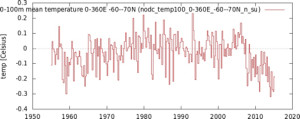
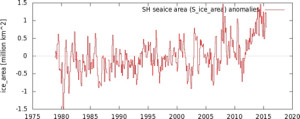

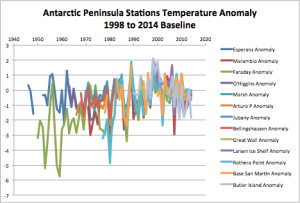
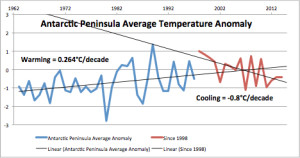
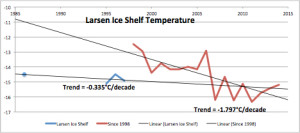





 Jim Hansen and his twin
Jim Hansen and his twin


No comments:
Post a Comment